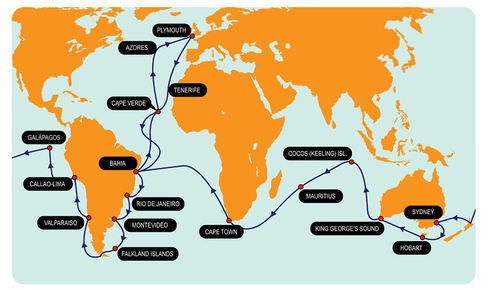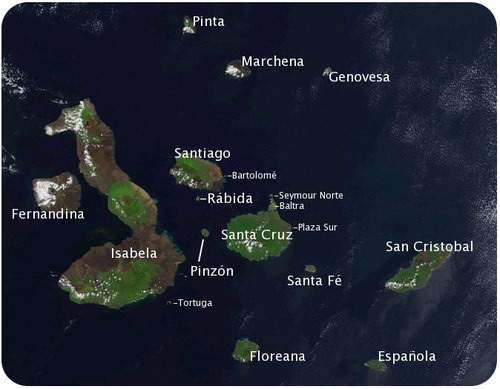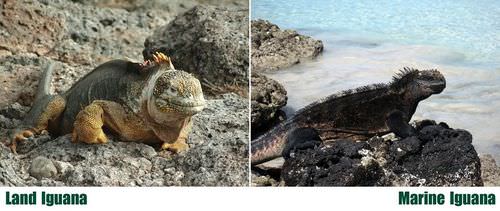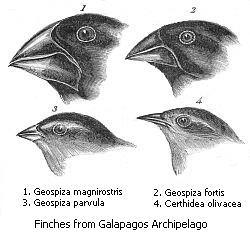4.1 演变理论理论
Section outline
-
Where in the world is this?
::这是哪里?This picture was taken in the Galápagos Islands , which is off the west coast of South America. The Galápagos Islands are home to many unique organisms , such as these tree-like cacti. Darwin's observations on these islands led to his development of the theory of evolution.
::这张照片是在南美洲西海岸外的加拉帕戈斯群岛拍摄的,加拉帕戈斯群岛拥有许多独特的生物,例如树类仙人掌。达尔文对这些岛屿的观察导致了他进化理论的发展。Darwin's Theory of Evolution
::达尔文的进化理论Do you ever wonder why some are big like ostriches and some birds are small like robins? Or why a lion has a mane while a leopard has spots? In the 19th century, an English natural scientist named Charles Darwin ( Figure ) was also fascinated by the diversity of life on Earth.
::你是否曾想过为什么有些大得像鱼,有些鸟小得像Robins? 或为什么狮子在豹斑点时有野马? 19世纪,英国自然科学家查尔斯·达尔文(Charles Darwn, Figure ) 也因地球上生物的多样性而着迷。He set out to answer the following questions:
::他开始回答下列问题:-
Why are organisms different?
::为什么生物是不同的? -
Why are organisms similar?
::为什么生物体相似? -
Why are there so many different types of organisms?
::为什么有这么多不同种类的生物?
To answer his questions, he developed what we now call "the theory of evolution by natural selection ." This theory is one of the most important theories in the field of life science . In everyday English, "evolution" simply means "change." In biology, evolution states that all living organisms came from earlier forms of life. The theory of evolution by natural selection explains why evolution occurs. Darwin spent over 20 years traveling around the world and making observations before he fully developed his theory.
::为了回答他的问题,他发展了我们现在所谓的“自然选择的进化理论 ” 。 这个理论是生命科学领域最重要的理论之一。在日常的英语中,“进化”只是“变化”的意思。在生物学中,进化表明所有生物都来自早期的生活形式。通过自然选择的进化理论解释了进化的原因。达尔文花了20多年的时间环游世界,在完全发展他的理论之前发表观察意见。Charles Darwin was one of the most influential scientists who has ever lived. Darwin introduced the world to the theory of evolution by natural selection, which laid the foundation for how we understand the living world today. Voyage of the HMS Beagle
::HMS Beagle 巡游In 1859, Charles Darwin published his book, On the Origin of Species by Means of (often known as The Origin of Species ). His book describes the observations and evidence that he collected more than 20 years of research, beginning with a five-year voyage around the world on a British research ship, the HMS Beagle . During the voyage ( Figure ), Darwin made observations about plants and animals around the world. He also collected specimens to study for when he returned to England.
::1859年,查尔斯·达尔文出版了他的书《物种来源(通常称为物种起源)》,书中描述了他收集的20多年研究的观察和证据,从英国一艘研究船HMS Beagle(HMS Beagle)的5年航行开始,开始在全世界航行。在航行期间(图),达尔文对全世界的动植物进行了观察。他还收集了样本,供他返回英国时研究。Each time the HMS Beagle stopped at a port, Darwin went on land to explore and look at the local plants, animals, and . One of the most important things Darwin did was keep a diary. He took detailed notes and made drawings of his observations.
::每次HMS Beagle在港口停留时,达尔文就到陆地上探寻和观察当地的植物、动物和。达尔文所做的最重要的一件事就是保存一本日记。他详细记录了自己的观察结果并绘制了图纸。Charles Darwin’s famous five year voyage was aboard the HMS Beagle from 1831-1836. The Galápagos Islands
::加拉帕戈斯群岛While the crew of the HMS Beagle mapped the coastline of South America, they traveled to a group of islands called the Galápagos. The Galápagos are a group of 16 volcanic islands near the equator, about 600 miles from the west coast of South America. Darwin spent months on foot exploring the islands. The specimens he collected from the Galápagos and sent back to England greatly influenced his ideas of evolution ( Figure ).
::在HMS Beagle的船员绘制南美洲海岸线地图时,他们前往称为Galápagos的一组岛屿,Galápagos是赤道附近、距南美洲西海岸约600英里处的16个火山岛组成的一组岛屿,达尔文徒步探索了这些岛屿数月,他从Galápagos收集的标本和送回英国的标本极大地影响了他的进化思想(图)。The Galápagos Islands are a group of 16 volcanic islands 600 miles off the west coast of South America. The islands are famous for their many species found nowhere else. It was on these islands where Darwin began to develop his theory of evolution. On the Galápagos, Darwin observed that the same kind of animal differed from one island to another. For example, the iguanas (large lizards) differed between islands ( Figure ). The members of one iguana species spent most of their time in the ocean, swimming and diving underwater for seaweed , while those of another iguana species lived on land and ate cactus. Darwin wondered why there were two species of iguanas on the same set of islands that were so different from one another. What do you think?
::在加拉帕戈斯岛,达尔文观察到,各岛的动物种类不同,例如,各岛屿(图层)之间的蜥蜴(大蜥蜴)不同。一个蜥蜴物种的成员大部分时间都花在海洋中,为海藻游泳和潜水,而另一个蜥蜴物种的成员则生活在陆地上和吃仙人掌。达尔文想知道,为什么在同一一系列岛屿上,有两种种类的蜥蜴彼此如此不同。你认为呢?The Galápagos iguanas are among the signature animals of the Galápagos Islands. Here both a land iguana and a marine iguana are shown. Giant Tortoises
::巨龟Darwin also observed giant tortoises on the Galápagos ( Figure ). These tortoises were so large that two people could ride on them. Darwin noticed that different tortoise species lived on islands with different environments. He realized that the tortoises had traits that allowed them to live in their particular environments. For example, tortoises that ate plants near the ground had rounded shells and shorter necks. Tortoises on islands with tall shrubs had longer necks and shells that bent upward, allowing them to stretch their necks ( Figure ). Darwin began to hypothesize that organisms developed traits over time because of differences in their environments. Darwin began to think that organisms evolved adaptations that allowed them to live in their environment. These adaptations were beneficial traits for their environment.
::达尔文还观测到了加拉帕戈斯(Figure)上的巨龟。这些巨龟非常大,有两人可以骑在它们上面。达尔文注意到,不同的乌龟物种生活在环境不同的岛屿上。他意识到,乌龟有能够让他们生活在特定环境中的特性。例如,在地面附近吃植物的乌龟有圆壳和短颈。在高灌木的岛屿上,有高灌木的乌龟有较长的颈部和贝壳,可以拉长颈部(Figure ) 。达尔文由于环境的不同,开始低估生物随着时间而发展特性。达尔文开始认为,生物会进化适应性,使他们能够在环境中生活。这些适应性能有利于环境。The name “Galápagos” means “giant tortoise.” When Darwin arrived on the Galápagos Islands, he was amazed by the size and variety of shapes of these animals. The giant tortoise (left) is a unique animal found only in the Galápagos Islands. There are only about 200 tortoises remaining on these islands. This Pinta Island tortoise (right) is able to reach leaves high in shrubs with its long neck and curved shell. Darwin's Finches
::达尔文的芬奇The most studied animals on the Galápagos are finches, a type of bird ( Figure ). When Darwin first observed finches on the islands, he did not even realize they were all finches. But when he studied them further, he realized they were related to each other. Each island had its own distinct species of finch. The birds on different islands had many similarities, but their beaks differed in size and shape.
::加拉帕戈斯群岛上研究最多的动物是鳍鸟,这是一种鸟类(图 ) 。 当达尔文第一次在群岛上观测鳍时,他甚至没有意识到它们都是鳍。当他进一步研究它们的时候,他意识到它们是相互联系的。每个岛屿都有独特的雀巢。不同岛屿上的鸟类有许多相似之处,但它们的嘴的大小和形状各有不同。Four of Darwin’s finch species from the Galápagos Islands. The birds came from the same finch ancestor. They evolved as they adapted to different food resources on different islands. The first bird uses its large beak to crack open and eat large seeds. Bird #3 is able to pull small seeds out of small spaces. In his diary, Darwin pointed out how each animal is well-suited for its particular environment. The shapes of the finch beaks on each island were well-matched with the seeds available on that island, but not the seeds on other islands. For example, a larger and stronger beak was needed to break open large seeds on one island, and a small beak was needed to eat the small seeds on a different island.
::达尔文在日记中指出了每只动物如何适合其特定环境。 每个岛上的尖嘴形状都与岛上的种子非常匹配,但与其他岛屿的种子不同。 比如,需要一只更大、更强大的嘴来打破一个岛上的大片种子,还需要一只小嘴去吃掉另一个岛上的小种子。Summary
::摘要-
Charles Darwin developed what we now call "the theory of evolution by natural selection."
::查尔斯·达尔文发展了我们现在所谓的“自然选择的进化理论”。 -
Darwin's observations on the Galápagos Islands suggested that animals are well-suited for their specific environments.
::达尔文对加拉帕戈斯群岛的观察表明,动物非常适合他们的具体环境。
Explore More
::探索更多Use the resource below to answer the questions that follow.
::利用以下资源回答以下问题。-
How long was
Darwin's
voyage on the
HMS Beagle
?
::达尔文在HMS Beagle上航行多久了? -
Did Charles Darwin conceive of natural selection on this voyage? Explain your answer.
::查尔斯·达尔文在此次航行中 是否设想了自然选择? -
What
did Darwin notice about the finches he observed on his voyag
e in the
Galápagos Islands? Why
do
the finches have differences in their beaks and claws?
::达尔文注意到他在加拉帕戈斯群岛航行时所观察到的雀巢是什么? 雀巢为什么在嘴和爪上有区别? -
How might the environment influence the way in which a certain species evolves?
::环境会如何影响某一物种的演变方式?
Review
::回顾-
Define biological evolution.
::定义生物进化。 -
Who was Charles Darwin?
::查尔斯·达尔文是谁? -
What is special about the Galápagos islands?
::加拉帕戈斯群岛有什么特别之处? -
Name an example of how animals were adapted for their specific environments on the Galápagos Islands.
::举一个例子,说明在加拉帕戈斯群岛上,动物是如何适应其特定环境的。
-
Why are organisms different?






